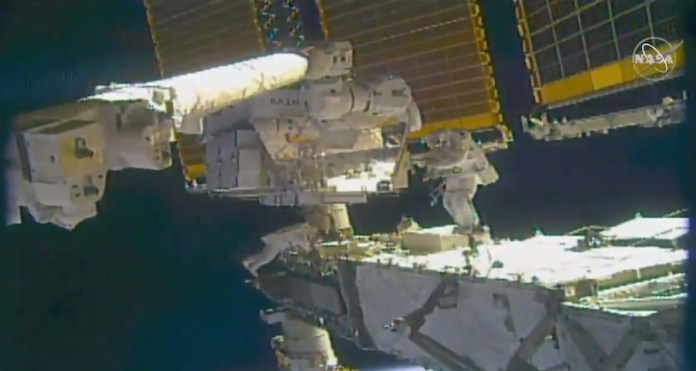Bob Behnken and astronauts Chris Cassidy work Beyond the International Space Station on Friday. Credit: NASA TV/Spaceflight NowTwo astronauts floated beyond the International Space Station for the first of four spacewalks that are planned to wrap a intricate endeavor to substitute 48 vessels that are aging in the lab electricity system with 24 canister components that are more powerful.
Getting away to a quick start, Robert Behnken and Chris Cassidy ran throughout the day, starting work for another spacewalk in the series Wednesday and completing their planned tasks all.
“I believe we have done enough for one evening,” one of the spacewalkers quipped before moving back into the airlock to wrap a six-hour seven-minute excursion.
The battery replacement work started in January 2017 and according to the outcome of Friday, the astronauts need to be able to complete the work ensuring smooth power distribution throughout the rest of the decade if not outside.
“I think that it’s safe to say, barring any unforeseen sort of failures, we are going to be useful on batteries for numerous years ahead,” said Kenny Todd,” deputy space station program manager at the Johnson Space Center in Houston. “The durability of the new technology batteries gets us well out through what will probably be the end of the program.”
Assisting with the laboratory robot arm from inside the channel have been Douglas Hurley, Behnken’s crewmate aboard the SpaceX Crew Dragon ferry boat which carried them to orbit last month, and cosmonaut Ivan Vagner, who launched aboard a Soyuz on April 9 with Cassidy and cosmonaut Anatoly Ivanishin.
Cassidy drifted off at about a half a mile a day and noted that a small wrist mirror, used to help him examine spacesuit screens that may not be viewed right, had worked loose. Tipping the scales at a tenth of a pound, the mirror that was lost posed no threat to the channel or the team, and in any instance Cassidy needed a spare.
NASA is wrap the replacement of 48 of the space station’s older-generation nickel-hydrogen batteries together with 24 smaller-yet-more-powerful lithium-ion units, together with circuit-completing”jack plates” to fill in for batteries which were removed but not replaced. The screws also provide long-term storage places for many of the previous batteries.
The batteries have been organized in sets of six in integrated electronics assemblies, or IEAs, at the foundations of the channel’s four solar array wings. Each wing consists of 2 extendable blankets of cells and the power they generate is delivered throughout the channel using channels, or eight buses, two per IEA.
Batteries in each IEA store electricity generated if the arrays are subjected to sun and then provide the power needed to keep the channel operating during the laboratory passes through the shadow of Earth.
The inboard right-side arrays are S4, truss segment, or part of the 4, providing 3A and channels 1A with power. The inboard arrays are P4 segment, or part of the 4.
With six units, the 12 inboard S4 array batteries were altered by spacewalkers in 2017 and at March 2019, the 12 inboard P4 batteries have been substituted by a second six LiOH batteries.
For each of those replacements, even the robot arm of the station needed the advantage necessary to assist the astronauts with battery relocations and only four spacewalks and unbolting were demanded. The outboard arrays and batteries pose a challenge.
During the following two this past January and two spacewalks last October, spacewalkers altered the batteries to get electricity channels 2B and 4B — at the far left end of the station’s truss — P6. The batteries in channel 4B were installed during NASA’s second and third all-female spacewalks.
Since the work site is far from the robot arm anchor point, four spacewalks were needed since the astronauts needed to manually transfer back batteries and forth where they had been installed.
Behnken and cassidy plan to execute four basically identical spacewalks to replace the 12 batteries in the outboard pair of arrays three powering channel three and 1B used by channel 3B, with six units.
During Friday’s excursion, the astronauts removed five of the six batteries from the 1B circuit, installed two batteries and 2 jack plates. During the spacewalk of the following week, the final battery in the 1B circuit will be removed and a third unit will be installed along with adapter plate.
During two spacewalks Cassidy and Behnken plan to replace the batteries in electricity channel 3B.
But these spacewalks will rely in part on how the initial two go and also the status of plans to bring Behnken and also Hurley back to Earth from the Crew Dragon ferry boat roughly Aug. 2. The two spacewalks might be deferred and completed by a station team, if problems crop up.
– Advertisement –
